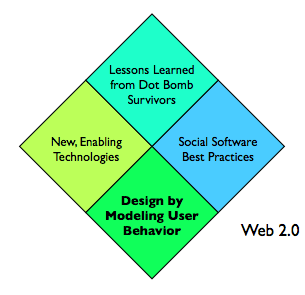Podcast of Web 2.0 Talk
Update: Added slide deck. Ok, this is scary. I’m posting a podcast of me giving a talk on Web 2.0. (also posted on Brain Sparks, the supremely interesting UIE blog). My wife assures me that my voice does indeed sound like that, (much to my dismay). I was asked to speak at an NEASIST event […]
Update: Added slide deck.
Ok, this is scary. I’m posting a podcast of me giving a talk on Web 2.0. (also posted on Brain Sparks, the supremely interesting UIE blog). My wife assures me that my voice does indeed sound like that, (much to my dismay). I was asked to speak at an NEASIST event called Buy, Hack, or Build: Optimizing your Systems for Your Users and Your Sanity. The two other speakers were Pete Bell of Endeca and Casey Bisson from Plymouth State University.
First, the podcast: Web 2.0 for the Rest of Us (60MB)
Second, the slide deck: Web 2.0 for the Rest of Us (2.2MB)
Here is a quick overview and some pretty graphics for those interested. It wasn’t exactly clear where they wanted me to come down (buy, hack or build), but I found out a little later they had recruited me for the “build”. Not knowing this, I made the argument that the history of the Web was all about hacking, and that hacking is really the only way to innovate.
Hacking = Design on the fly
In my talk, which I gave with the highly recommended Apple Keynote, I equated hacking with design on the fly. There are several outcomes of designing on the fly:
- A focus on context and current user needs instead of standards and conventions
- Brings the ire of purists (Google.com doesn’t validate…oh the horror!)
- Lends itself to multiple iterations, trial/error
- How innovation most often happens, especially on the Web
Four Aspects of Web 2.0
I also made it clear that I wasn’t going to define Web 2.0, as most of the definitions I’ve heard are ambiguous, to say the least. Instead, I focused on four aspects of Web 2.0 that I think are most relevant. Here they are:

These four aspects I broke down as follows:
- Learning from the Dot Bomb Survivors
The Four Horsemen: Google, Amazon, Yahoo, and eBay. These companies have become cliché, and we take them for granted, even though they have consistently come up with the most innovative designs. Amazon’s reviews? Yeah, they’re cool. But why are they consistently better than anyone else’s reviews? That’s the question. - New, Enabling Technologies
RSS, APIs, REST, and Permalinks. These technologies haven’t been around all that long, and they’re crucial to today’s applications. - Social Software Best Practices
Folksonomies, Blogs, Wikis are changing the way that we interact with each other on the Web. What are the best practices in implementing these? We’ve learned a lot about folksonomies, but it seems we’ve only scratched the surface. - Design by Modeling User Behavior
This is what the other quadrants point to. Learn from the Dot Bomb Survivors and identify best practices in social software while observing analog user activities. Then use new, enabling technologies to model them digitally.
In other words, I think that Web 2.0 is all about learning how to design systems that model user behavior. This is similar to many other ideas that folks have put forward about Web 2.0, including Tim O’Reilly’s harnessing collective intelligence and John Hagel’s distributed, collaborative and cumulative creation.
Where my view differs from theirs is that I characterize Web 2.0 as simply modeling what we already do in our offline, analog lives. Societies have always harnessed collective intelligence, albeit on a small scale and in a very lossy way. We’ve always done distributed, collaborative, and cumulative creation, just at much smaller distances and without recording it in bytes. The new wave is simply bigger, online, recorded, and digital.
In short, I think Web 2.0 is about modeling something that already exists in our offline worlds, mostly in the spoken words and minds of humankind.
I hope you enjoy the talk.
Previous